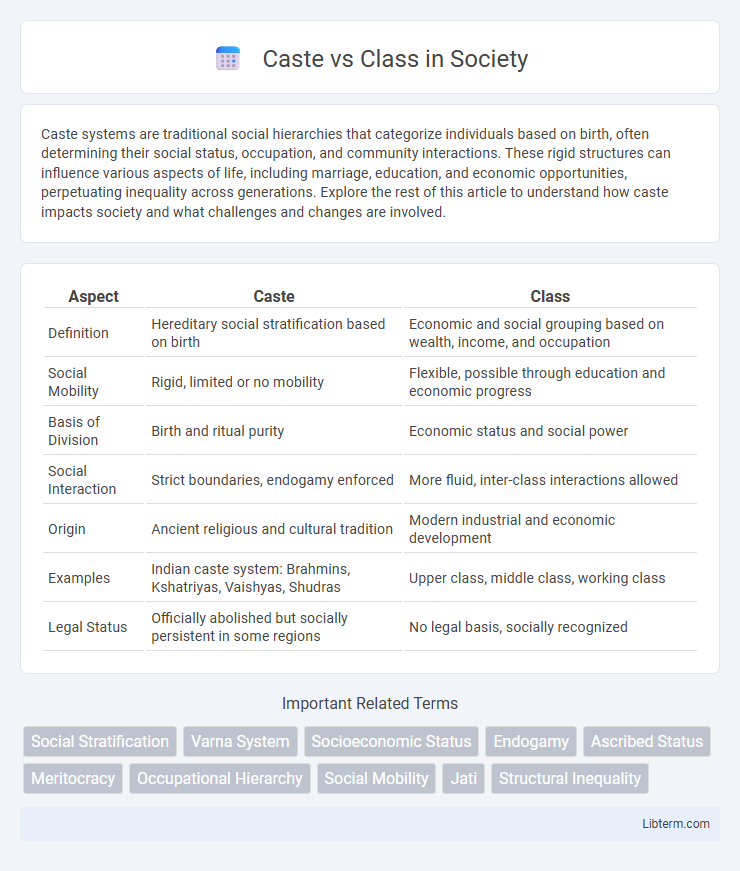Caste systems are traditional social hierarchies that categorize individuals based on birth, often determining their social status, occupation, and community interactions. These rigid structures can influence various aspects of life, including marriage, education, and economic opportunities, perpetuating inequality across generations. Explore the rest of this article to understand how caste impacts society and what challenges and changes are involved.
Table of Comparison
| Aspect | Caste | Class |
|---|---|---|
| Definition | Hereditary social stratification based on birth | Economic and social grouping based on wealth, income, and occupation |
| Social Mobility | Rigid, limited or no mobility | Flexible, possible through education and economic progress |
| Basis of Division | Birth and ritual purity | Economic status and social power |
| Social Interaction | Strict boundaries, endogamy enforced | More fluid, inter-class interactions allowed |
| Origin | Ancient religious and cultural tradition | Modern industrial and economic development |
| Examples | Indian caste system: Brahmins, Kshatriyas, Vaishyas, Shudras | Upper class, middle class, working class |
| Legal Status | Officially abolished but socially persistent in some regions | No legal basis, socially recognized |
Understanding Caste and Class: Fundamental Definitions
Caste is a hereditary social stratification system primarily based on birth, with rigid boundaries and often linked to religious or cultural traditions, especially prominent in South Asia. Class refers to socioeconomic groupings determined by factors like income, education, occupation, and wealth, allowing more fluidity and mobility within society. Understanding caste involves recognizing its fixed, inherited nature, while class highlights economic status and potential for upward or downward movement.
Historical Origins of Caste and Class
The historical origins of caste trace back to ancient Indian society, where social stratification was codified in religious texts like the Manusmriti, establishing hereditary and endogamous groups based on occupation and ritual purity. Class systems, in contrast, emerged primarily during the rise of industrial capitalism in Europe, characterized by fluid social mobility linked to economic wealth, labor relations, and access to resources. While caste remains rigid and ascribed from birth, class is more dynamic, influenced by economic factors and social change over time.
Structural Differences: Caste vs. Class
Caste systems are rigid social hierarchies based on hereditary status and usually involve fixed roles, restrictions on social mobility, and endogamous marriage practices. Class systems are more fluid socioeconomic divisions determined by factors such as wealth, education, and occupation, allowing for social mobility through personal effort or economic changes. Structural differences between caste and class highlight the immutability of caste positions contrasted with the dynamic nature of class status.
Social Mobility in Caste and Class Systems
Caste systems rigidly inhibit social mobility through hereditary status and strict social segregation, preventing individuals from changing their social position. In contrast, class systems allow greater social mobility based on economic achievement, education, and individual effort, enabling movement upward or downward within the social hierarchy. Studies in sociology highlight that caste-bound societies often face persistent inequality due to lack of mobility, whereas class-based societies exhibit more fluid and dynamic social structures.
Economic Impacts of Caste and Class
Economic impacts of caste and class significantly influence income distribution, employment opportunities, and social mobility. Caste-based economic disparities often restrict access to education and skilled labor markets, perpetuating poverty within marginalized communities. Class structures shape wealth accumulation and economic power, with higher classes controlling capital and resources, thereby reinforcing systemic inequality.
Cultural and Religious Influences
Caste systems are deeply rooted in religious doctrines and cultural traditions, particularly in Hinduism, where varnas and jatis define social hierarchy and occupational roles. Class stratification is primarily influenced by economic factors and social mobility, often shaped by cultural capital and education rather than hereditary religious mandates. Religious beliefs legitimize caste distinctions, limiting inter-caste interactions, while class distinctions tend to be more fluid and impacted by broader societal changes and economic opportunities.
Discrimination and Social Inequality
Caste and class systems both generate social inequality by restricting access to resources and opportunities based on inherited status or economic position. Caste-based discrimination involves rigid, hereditary divisions that enforce social exclusion and limit upward mobility, particularly prominent in societies like India. Class discrimination, often linked to economic disparities, creates social stratification where wealth and occupation influence power dynamics and social privileges.
Modern Transformations: Caste and Class Today
Caste and class continue to influence social structures, but modern transformations have blurred traditional boundaries through urbanization, education, and economic mobility. The rise of the middle class and affirmative action policies have created new opportunities for historically marginalized castes, altering social dynamics and access to resources. Digital technology and globalization accelerate these changes, enabling identity redefinition beyond inherited caste hierarchies toward class-based social stratification.
Global Perspectives: Caste vs. Class Beyond India
Caste and class systems shape social hierarchies worldwide, with caste primarily linked to hereditary status as observed in South Asia, while class pertains to economic and social mobility influenced by wealth, education, and occupation. In regions like Latin America and Africa, caste-like stratifications emerge through ethnic divisions and colonial legacies, whereas class structures dominate Western societies through capitalist frameworks and labor relations. Understanding these distinctions reveals global intersections of social inequality, highlighting how cultural, historical, and economic factors produce varied forms of social stratification beyond the Indian context.
Moving Forward: Towards Social Justice and Equality
Achieving social justice and equality requires dismantling both caste-based discrimination and class-based inequalities through comprehensive policies that promote education, economic opportunity, and legal protections. Empowering marginalized communities with access to resources and representation fosters inclusive growth and counters systemic barriers rooted in historical oppression. Sustainable progress hinges on collaborative efforts between government, civil society, and grassroots movements to ensure equitable rights and social mobility for all individuals.
Caste Infographic

 libterm.com
libterm.com